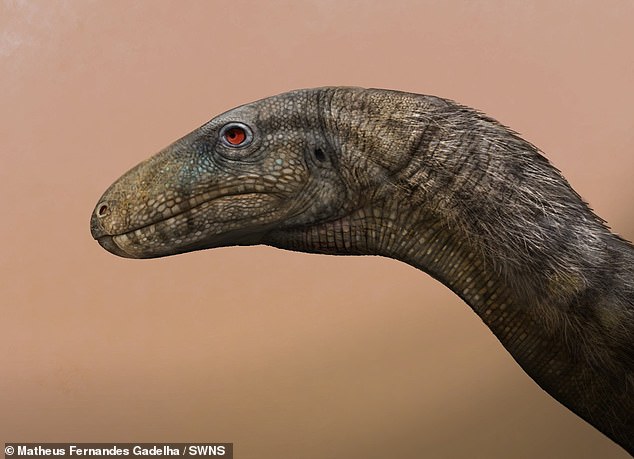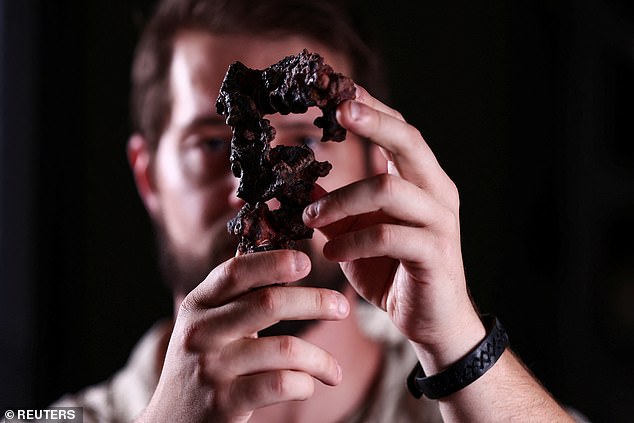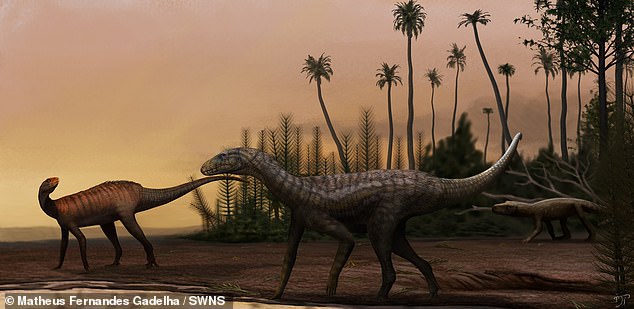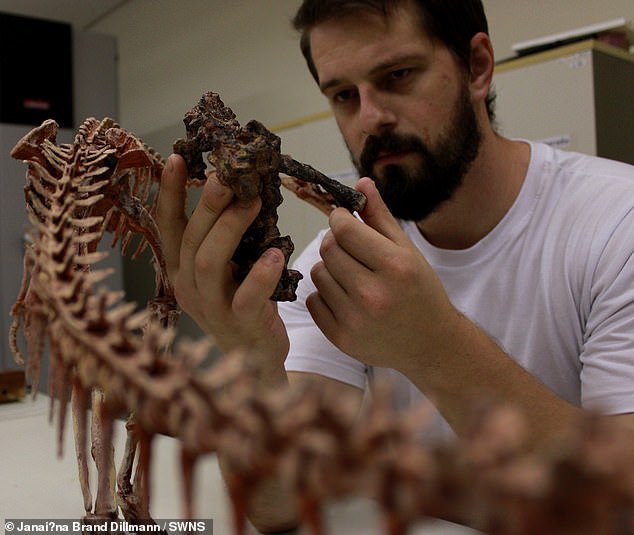Scientists find ‘missing link’ animal that caused rise of dinosaurs as they discover oldest fossil ever
One of the oldest fossils ever discovered could finally unravel the mystery of how common lizards evolved into dinosaurs.
Paleontologists have identified a 237-million-year-old four-legged new reptile species in Brazil, about the size of a small dog.
The newly found species, called Gondwanax paraisensis, showed several features common to the early ancestors of dinosaurs, and some have never been found before.
The team believes that the fossil signatures could help fill in the gaps in evolutionary history.
Above, paleontologist Rodrigo Temp Müller holds a fossil of the new species, called ‘Gondwanax paraisensis’, next to a modern-day fossil of ‘Prestosuchus chiniquensis’, a species that also lived 237 million years ago.
This ancient reptile was first discovered by a local doctor in the town of Paraiso do Sull, who later donated the fossil in 2021.
A reanalysis of the remains conducted by researchers from the Federal University of Santa Maria found that the creature roamed the land during the Triassic, when mammals, crocodiles, turtles and frogs first emerged.
The arrival of other animals meant that the ancient reptile had to struggle for survival, as they all lived on the supercontinent Pangea, which had a fierce jungle ecosystem that was sweltering in a climate much hotter than ours today.
The reptile has some features found in dinosaur ancestors known as silesaurids, such as a notch under the head of the femur and a flat surface at the top of the femur where it connects to the hip.
The properties helped scientists determine that Gondwanax paraisensis must be one of the oldest known silesaurids.
But the team identified a unique bone feature that connected the spine to the hips.
This area, known as the sacrum, consisted of three vertebrae
The 39-inch-long, up to 13-pound lizard’s name means “lord of Gondwana” in honor of the southernmost region of the Pangea, known as the Gondwana landmass.
Paleontologist Rodrigo Temp Müller noted that the creature’s vertebrae showed it was likely an “agile and lightweight animal.”
Its unique, competitive abilities and its presence near so many other fossils from the same Triassic period will help researchers understand the ecosystem in which dinosaurs first evolved.
“Because it is so old, it gives us clues about how dinosaurs came to be,” says Müller.
“The most important part of this finding is its age,” he explained.

Above, an illustration of ‘Gondwanax paraisensis’, now believed to be an ‘agile and lightweight’ ancestor of the dinosaurs – dating back 237 million years

Paleontologist Müller holds up a fossilized piece of Gondwanax paraisensis vertebrae
Paleontologists have long debated whether silesaurids themselves were true dinosaurs, simply “non-dinosaur dinosauriforms,” or possibly an ancestor of these famous and gigantic creatures that once ruled the Earth.
“Understanding the characteristics of these precursors could shed light on what was crucial to the evolutionary success of the dinosaurs,” Müller and his team said in a statement.
And the region itself played a key role in the major evolutionary shifts that took place.
A vast mountain range called the ‘Transgondwanan Supermountain’ – which reaches as high as the Himalayas but is almost four times as long – has ‘supercharged’ the evolution of life, Australian scientists discovered in 2022.
The appearance of the first large animals about 575 million years ago coincided with the tectonic formation of this area, according to geochemist Dr Ziyi Zhu of the Australian National University in Canberra.
“There is nothing comparable to these two areas today,” Dr. Zhu said at the time.
It was the gradual erosion of these megamountains by weather elements that led to essential nutrients, such as iron and phosphorus, entering the oceans in greater quantities, Dr. Zhu and her team explained.
This influx of ingredients helped fuel life and evolution into larger and more complex forms.
The resulting increase in oxygen-producing plant-like algae and other species, accompanied by the rapid burial of organic carbon and iron, would have led to an increase in oxygen levels in the atmosphere.
“The increase in atmospheric oxygen associated with the erosion of the Transgondwanan Supermountain is the largest in Earth’s history and was an essential condition for the appearance of animals,” said Dr Zhu.
The second half of the name of the new reptile discovery, paraisensis, was chosen to pay respect to Paraiso do Sul, the city in Brazil’s southernmost state, Rio Grande do Sul, where the fossil was first unearthed.

Gondwanax paraisensis in a Triassic landscape, million years ago, southern Brazil (painting)

Paleontologist Müller with more fossilized pieces of Gondwanax paraisensis
Müller noted that the local doctor who donated the fossil, Dr. Pedro Lucas Porcela Aurelio, could only make out some visible parts of the creature’s vertebrae when he first examined the thick rock surrounding the fossil.
Dr. Aurelio first noticed the fossil in 2014, without knowing that the find dated from the Triassic, between 252 million and 201 million years ago.
“It’s extraordinary to be the first human to touch something from 237 million years ago,” Dr Aurelio told Reuters.
“It’s an indescribable feeling,” the local doctor continued, adding that he has been a paleontology buff since childhood.
